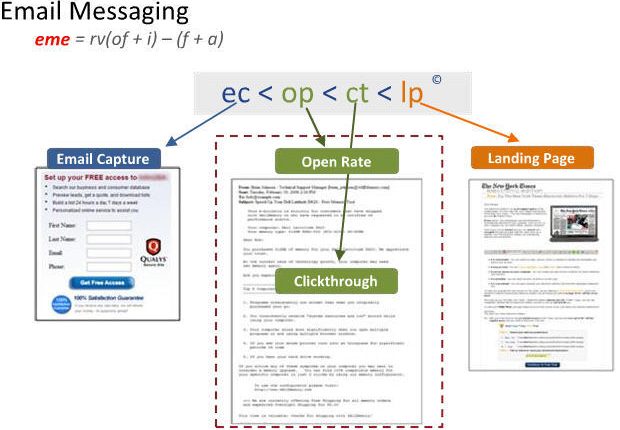Email marketing is a very popular topic and most likely you’ve read a number of articles covering different ways to improve email marketing campaigns. Whether you are an experienced pro, or relatively new to the subject, it never hurts to review the basics and think about the process of email marketing optimization from the building blocks on up. I recently joined MarketingSherpa as a reporter and I’ve been taking the online certification and training courses offered by MarketingExperiments. A couple of weeks ago I had a popular post at the MarketingSherpa blog on email marketing optimization, looking at the process through the lens of email capture. This week I’m covering email messaging, the heart of email marketing.
Here is the basic MarketingExperiments heuristic for email marketing optimization:
For this post we will be focused on the two middle elements, open rate and clickthrough.
And if you’ve already taken our course on email marketing optimization, this heuristic will also be familiar:
This formula is applied to each of the elements in the first heuristic, and it is the key to understanding the psychology of your target audience.
Defining relevance
Take a look at the circled area in the above chart. Both the offer relevance and incentive relevance are on the positive side of the ledger, and if they are done correctly both are working for you in achieving email opens and clickthroughs to the landing page.
What is relevance? Relevance is the compatibility between the email message and the recipient’s motivations. It can be based on both internal motivations (e.g. demographics, shopping habits) of the recipient and external events (e.g., seasonality, limited-time offer) surrounding the recipient. Essentially, relevance is showing up with the right offer at the right time.
To further define the two specific types of relevance in the heuristic, the offer relevance is the value you promise in your email in exchange for a click and the incentive relevance is an appealing element introduced in your email to achieve a desired action.
Keeping the email message simple and direct helps to optimize relevance:
- Use specific quantitative language, not fuzzy qualitative language, in both the subject line (to inspire an open) and body of the email message (to inspire clickthrough).
- Don’t send a webpage as the body of the email. It may be tempting from a design standpoint with HTML email messages, but keep the email message simple. The goal is a clickthrough to the landing page. Which leads directly to the next bullet point …
- Don’t oversell in the email. The goal is to get a clickthrough to the landing page, not make your entire sales pitch. Your offer in the email message is the additional information the recipient will get in exchange for a click.
The negatives
Now let’s take a look at the other side of the ledger and the elements in the heuristic that are working against your success.
Friction is psychological resistance to a given element in the email. Three elements contribute to friction in email messages: length, difficulty and tone in the email body content.
Anxiety is psychological concern stimulated by a given element in the email process, and includes both legitimate concern and perception of concern. Both types of concern need to be addressed because if you don’t account for the perception of anxiety, you will not achieve fully optimized results. In fact your goal should be to remove all anxiety from your email message.
Friction should be approached a little differently. According to our testing, reducing friction offers a very high return on those efforts and is one of the most effective ways to increase conversion. Keep in mind that some friction is necessary.
Requesting an email open and a clickthrough to the landing page is an element of friction, so for optimization purposes you want to reduce friction to the absolute minimum. The incentive (discussed above) can then remove the last bit of friction resistance to the offer.
Learning to fish
When optimizing email messaging, take the time to think about each element from offer and incentive relevance to friction and anxiety, and remember there are no “best practices” that you can apply over and over again to achieve email message optimization. I like to think of the Chinese proverb, “Give someone a fish and you’ve fed them for a day. Teach them to fish and you’ve fed them for life.”
Learning about best practices is similar to being handed a fish. If you don’t eat it (use the best practices) immediately, it’s going to go bad. Learning the building blocks of email marketing optimization is similar to learning how to fish. You can lean on that knowledge every day to catch a new fish — or make an email marketing campaign even better.
Related resources
MarketingExperiments Online Training and Certification Courses
MarketingExperiments Email Marketing Course
Internet Marketing for Beginners: Email marketing optimization 101
Ten Numbers Every Email Marketer Should Commit to Memory
Email Marketing: “I am not dead yet”




My thing about email marketing..is to just keep it simple and people will signup..and don’t spam them..
“TrafficColeman “Signing Off”
Also you need to have your leads perceive you as a trustworthy person, gaining a persons trust is relatively easy if you allow them into the content of your product and how it will help them become successful online. So emphasizing on the importance of being transparent to your leads is a key factor in escalating your sales substantially.
Here is my free extensive 6 page blog post on writing dynamite email campaigns. !->http://bit.ly/a58lc4<-!